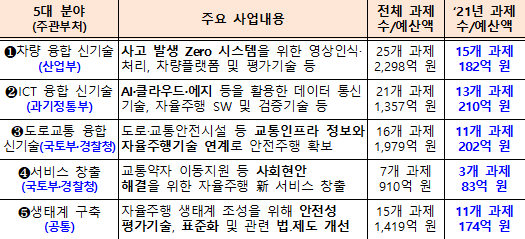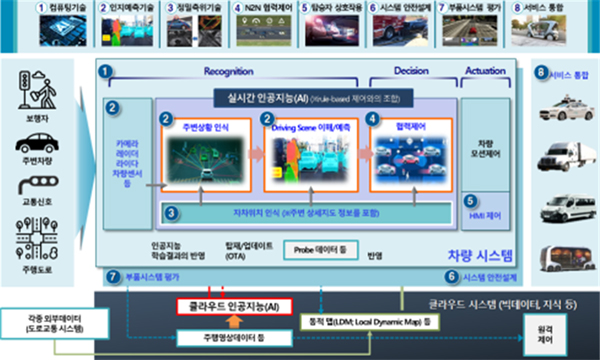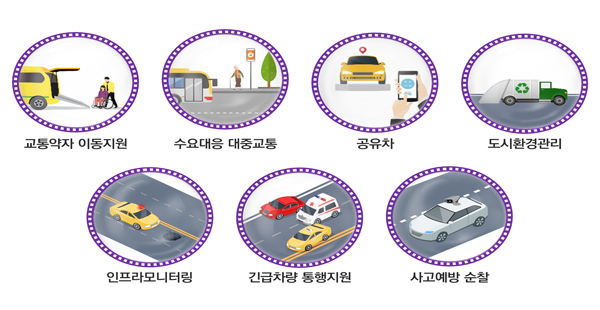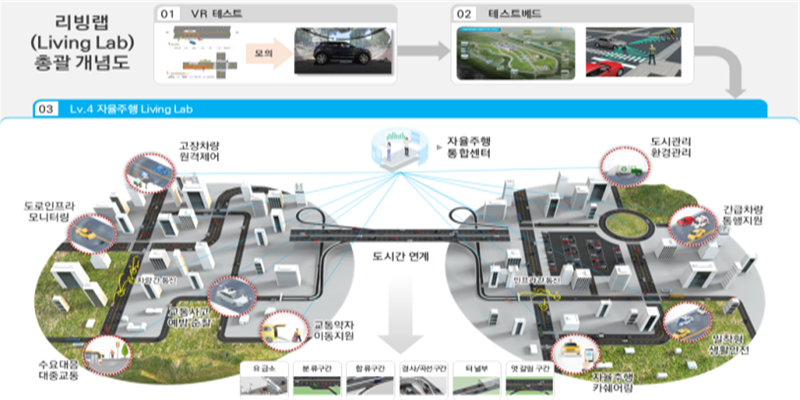차량 스스로 상황을 판단해 비상시에도 운전자의 개입이 불필요한 레벨4 수준 완전자율주행 구현은 차량과 부품뿐 아니라 인프라 등의 변화도 요구된다. 국토교통부, 산업통상자원부, 과학기술정보통신부, 경찰청 등 4개 기관은 850.4억 원이 투입되는 2021년 ‘자율주행기술개발혁신사업’ 신규과제 53개를 공고했다. 해당 사업에는 올해부터 2027년까지 총 1조974억 원이 투입된다.
올해부터 자율주행기술개발혁신사업 시작
자율주행 사업 위해 ICT, 인프라 등 지원
4개 부처, 3월 중 자율주행 사업단 출범
현재 자율주행기술은 운전자의 주행을 보조하는 레벨2 수준이다. 운행 가능 영역에서 비상시 운전자 개입이 필요한 조건부 자율주행이 가능한 레벨3 자율주행차량은 향후 1~2년 내 출시될 예정이다. 하지만, 차량 스스로 상황을 판단해 비상시에도 운전자의 개입이 불필요한 레벨4 수준 완전자율주행 구현은 차량과 부품뿐 아니라 인프라 등의 변화도 요구된다.
국토교통부, 산업통상자원부, 과학기술정보통신부, 경찰청 등 4개 기관은 15일, 850.4억 원이 투입되는 2021년 ‘자율주행기술개발혁신사업’ 신규과제 53개를 공고했다. 해당 사업에는 올해부터 2027년까지 총 1조974억 원이 투입된다.

▲ 5대 분야 주요 사업내용 및 지원계획안 [표=정부]
4개 부처는 2027년 레벨4 완전자율주행 기반 완성을 목표로 ▲차량 융합 신기술 ▲ICT 융합 신기술 ▲도로교통융합 신기술 ▲서비스 창출 ▲생태계 구축 등 5대 분야를 지원할 계획이다.
먼저, 레벨4 자율주행차량 핵심 기술인 △자율주행 컴퓨팅기술, △인지예측 센싱 기술, △정밀 측위(Positioning) 기술, △협력 제어 기술, △자동차-탑승자 상호작용 기술, △안전설계 기술 등의 개발을 추진한다. 올해에는 핵심 인지 센서 모듈, AI 기반 고성능 컴퓨팅기술, 자율주행 플랫폼 등 15개 과제(182억 원)를 착수한다.

▲ 차량 융합 신기술 기술개발 개념도 [그림=정부]
다음, 자율주행의 안전강화 및 지능고도화를 위해 △고성능 클라우드 서버와 교통 인프라의 에지 컴퓨팅 간 연계한 자율주행 3티어 구조, △차량 내외부를 연결하는 차량 통신(V2X), △보안기술 등을 개발하며, 올해에는 △자율주행 인지·판단·제어 AI 소프트웨어 기술, 자율주행 학습데이터 수집·가공 기술 등 13개 과제(210억 원)에 들어간다.
또한, 차량의 센서로만 구현하기 어려운 레벨4 수준 자율안전운행을 위해 △도로교통 시설과 융합방안, △다양한 교통 주체(운전자·차량·보행자·인프라·교통센터 등) 간 연계 협력 방안 등을 개발하며, 올해에는 디지털 도로·교통 인프라 융합 플랫폼, 도로상황 인지 고도화 기술 등 11개 과제(202억 원)를 착수한다.

▲ 7대 자율주행 공공서비스 [그림=정부]
그리고, 자율주행 기반의 새로운 서비스 창출을 위해 △교통약자 이동지원, △실시간 수요 대응 자율주행 대중교통 서비스, △자율주행 공유차 서비스, △긴급차량 통행 지원 등 다양한 서비스 개발을 추진한다. 올해에는 교통약자 지원, 수요대응 대중교통, 도로교통 인프라 모니터링 및 긴급복구 지원 등 3개 과제(83억 원)에 들어간다.
마지막으로, 자율주행 분야 생태계 조성을 위해 △글로벌 표준체계 및 시험표준 개발(국제표준 5건 이상 반영 목표), △충돌상황 대비 안전성 평가기술, △자율주행 교통사고 분석시스템 개발 및 관련 법·제도개선을 병행한다. 올해에는 표준, 안전성 평가기술 등 생태계 구축 관련 모든 과제(11개) 과제(174억 원)를 착수한다.
◇ 3월 중 자율주행 사업단 공식 출범
4개 부처는 향후 성과물의 사업화를 지원할 계획이다.
사업화 가능성 제고 및 사업성과 확산을 위해 자동차 제조사나 티어 1 부품기업 같은 수요기업의 참여를 의무화한 수요연계형 과제를 기획하고, 과제 선정평가 때 사업화 및 경제성에 대한 배점을 높이고(30→40점), 수행기관의 사업화 이력 제출을 의무화한다.
과제목표를 탄력적으로 변경할 수 있는 이동표적제를 적용, 자율주행 수요기업과의 협의체를 구성하여 관련 시장 트렌드를 반영하고, ICT 분야 결과물은 기업과 학계 등에서 자유롭게 활용할 수 있도록 공개 소프트웨어 방식으로 제공할 계획이다.

▲ 자율주행 리빙랩 예시 [그림=정부]
또한, 국민이 체감할 수 있는 7대 자율주행 서비스를 개발하고, 개발된 자율주행 서비스는 2023년부터 도시 규모 리빙랩 실증환경에서 2027년까지 실증을 시행하여 국민의 자율주행 수용성을 높여갈 방침이다.
4개 부처는 오는 3월 중 가칭 ‘자율주행기술개발혁신 사업단’을 공식 출범시켜 사업 통합관리 및 사업성과 창출에 나설 계획이다. 과제접수 기간은 2.1(월)~2.17(수) 예정이며, 세부 과제제안서(RFP)는 한국산업기술평가관리원(KEIT), 정보통신기획평가원(IITP), 국토교통과학기술진흥원(KAIA) 및 경찰청 홈페이지에서 확인할 수 있다.



